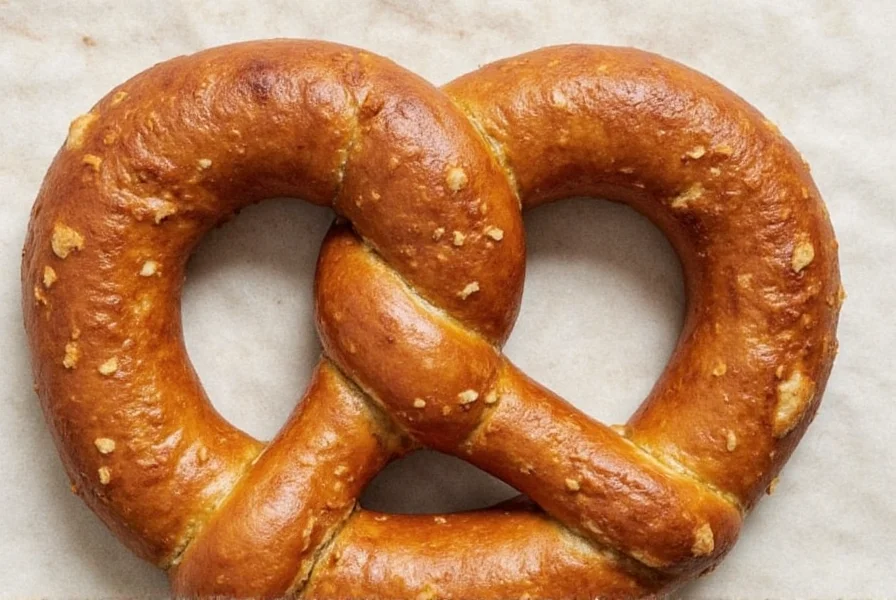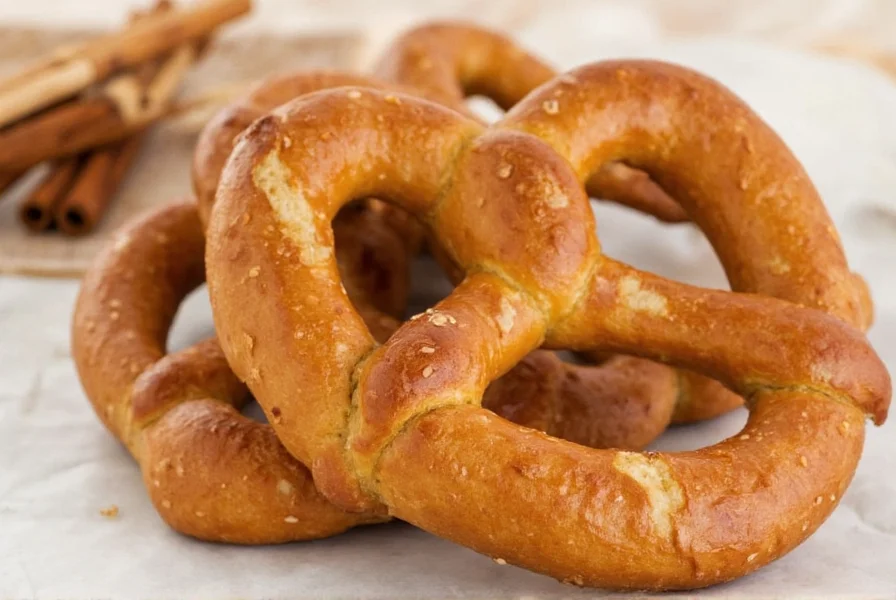Cinnamon pretzels represent the perfect marriage of traditional German baking and American sweet tooth preferences. These delightful treats transform the classic salty pretzel into a dessert-worthy snack through a simple yet transformative cinnamon-sugar coating. Understanding the science behind the dough preparation and proper coating technique separates mediocre homemade versions from truly exceptional ones that rival professional bakery offerings.
The Origins of Cinnamon Pretzels
While pretzels themselves date back to 610 AD in medieval Europe, the sweet cinnamon variation emerged much later in American baking culture. German immigrants brought pretzel-making traditions to Pennsylvania in the 1700s, but the sweet version didn't gain popularity until the late 20th century. The first commercial cinnamon pretzels appeared in mall food courts during the 1980s, where their enticing aroma and handheld convenience made them instant favorites. Today, both artisanal bakeries and home cooks create variations ranging from traditional soft pretzels to crunchy baked versions.
Classic Homemade Cinnamon Pretzel Recipe
Creating authentic cinnamon pretzels requires attention to dough hydration, proofing time, and the critical boiling step that gives pretzels their distinctive chewy texture. This tested recipe yields twelve perfect cinnamon pretzels with golden-brown exteriors and soft, airy interiors.
| Ingredient | Measurement | Key Purpose |
|---|---|---|
| All-purpose flour | 3½ cups | Provides structure and chew |
| Active dry yeast | 2¼ teaspoons | Creates proper rise and texture |
| Granulated sugar | ¼ cup | Feeds yeast and balances flavor |
| Salt | 1½ teaspoons | Controls yeast activity |
| Unsalted butter | 4 tablespoons | Enriches dough and improves texture |
| Water | 1 cup warm | Activates yeast and hydrates flour |
| Cinnamon | 2 tablespoons | Primary flavor component |
| Granulated sugar (for coating) | ½ cup | Creates sweet crunchy exterior |
Step-by-Step Preparation
- Mix the dough: Combine warm water (110°F), sugar, and yeast. Wait 5 minutes until foamy. Add melted butter, salt, and 2 cups flour. Mix until smooth.
- Knead: Gradually add remaining flour until dough pulls away from bowl. Knead 5-7 minutes until smooth and elastic. Properly developed dough should pass the "windowpane test" where stretched dough becomes translucent without tearing.
- First rise: Place in oiled bowl, cover, and let rise 1 hour or until doubled. Temperature affects rise time—cooler environments require longer proofing.
- Shape: Divide into 12 equal pieces. Roll each into 20-inch ropes. Form into pretzel shapes by making a U-shape, crossing ends twice, and pressing to bottom curve.
- Boil: Bring 6 cups water and ⅓ cup baking soda to gentle boil. Dip each pretzel 20-30 seconds per side. This critical step creates the signature chewy texture and deepens browning.
- Second rise: Place on parchment-lined baking sheets. Let rest 10 minutes while preheating oven to 450°F.
- Bake: 12-14 minutes until deep golden brown. Rotate sheets halfway through baking.
- Coat: While still warm, brush with melted butter and generously coat with cinnamon-sugar mixture (⅓ cup sugar + 1½ tablespoons cinnamon).
Perfecting Your Cinnamon Pretzel Technique
Several factors determine whether your homemade cinnamon pretzels achieve bakery-quality results. The baking soda bath concentration significantly impacts texture—too little creates pale, dense pretzels while too much produces an unpleasant metallic taste. For optimal results, use exactly ⅓ cup baking soda per 6 cups water.
Temperature control proves equally crucial. Water temperature for yeast activation must stay between 105-115°F—too hot kills yeast, too cold prevents proper activation. During baking, the initial high heat (450°F) creates steam that helps the pretzels rise before the crust sets.
Popular Cinnamon Pretzel Variations
Culinary creativity has produced numerous delicious variations on the classic cinnamon pretzel:
- Cinnamon sugar soft pretzel bites: Cut shaped dough into 1-inch pieces before baking for perfect party snacks
- Stuffed cinnamon pretzels: Fill with cream cheese, chocolate, or caramel before shaping
- Gluten-free cinnamon pretzels: Substitute with 1:1 gluten-free flour blend and add 1 teaspoon xanthan gum
- Vegan cinnamon pretzels: Replace butter with coconut oil and use plant-based milk
- Crunchy baked cinnamon pretzels: Skip the boiling step and bake thinner dough for a crispy texture

Troubleshooting Common Cinnamon Pretzel Problems
Even experienced bakers encounter issues with cinnamon pretzels. Understanding these common problems helps achieve consistent results:
- Dense texture: Usually indicates under-proofed dough or expired yeast. Ensure proper rise time and test yeast viability before starting.
- Pale color: Insufficient baking soda in boiling water or oven temperature too low. Verify measurements and use an oven thermometer.
- Soggy coating: Applying cinnamon sugar to cooled pretzels. Always coat while pretzels are still warm for proper adhesion.
- Uneven browning: Inconsistent oven temperature. Rotate baking sheets halfway through baking.
- Flat shape: Over-proofed dough loses structure. Monitor rise time carefully, especially in warm environments.
Serving and Storage Recommendations
Cinnamon pretzels deliver peak flavor when consumed within 24 hours of baking. For optimal freshness, store in airtight containers at room temperature. Avoid refrigeration, which accelerates staling. To refresh day-old pretzels, warm in a 300°F oven for 5-7 minutes.
Pair cinnamon pretzels with complementary flavors for enhanced enjoyment. Dipping in melted chocolate, cream cheese frosting, or vanilla icing creates a decadent treat. For breakfast pairings, serve alongside coffee or hot chocolate. The ideal cinnamon-to-sugar ratio (typically 1:4) balances warmth without overwhelming sweetness—adjust to personal preference.
Frequently Asked Questions
What's the secret to making soft cinnamon pretzels instead of hard?
The key to soft cinnamon pretzels lies in the baking soda bath before baking. Boiling the shaped dough in a baking soda solution for 20-30 seconds creates a gelatinized surface that limits expansion during baking, resulting in the characteristic chewy texture. Proper dough hydration (65-70% water-to-flour ratio) also contributes to softness.
Can I make cinnamon pretzels without a stand mixer?
Yes, you can make excellent cinnamon pretzels by hand. Mix ingredients in a large bowl until shaggy, then turn onto floured surface and knead 8-10 minutes until smooth and elastic. The windowpane test (stretching a small piece of dough thin enough to see light through without tearing) confirms proper gluten development. Hand-kneaded dough often develops better flavor due to slower oxidation.
Why do my homemade cinnamon pretzels taste different from store-bought?
Commercial cinnamon pretzels often contain dough conditioners, preservatives, and additional ingredients not found in home recipes. The primary differences come from professional equipment (higher temperature ovens, steam injection) and precise baking soda concentration in the boiling solution. For closer results, increase baking soda to ½ cup per 6 cups water and bake at 475°F for the first 5 minutes before reducing to 425°F.
How can I prevent my cinnamon sugar coating from falling off?
Apply the cinnamon sugar coating while pretzels are still warm (140-160°F) but not hot. First brush with melted butter or a simple syrup (equal parts water and sugar, boiled 2 minutes) to create a sticky surface. Use a 4:1 sugar-to-cinnamon ratio for optimal adhesion. Toss pretzels gently in the mixture rather than sprinkling to ensure even coverage.
What's the best way to freeze cinnamon pretzels for later?
Freeze uncoated pretzels after the second rise but before baking. Arrange on parchment-lined baking sheets, freeze solid (2 hours), then transfer to freezer bags. When ready to bake, add 2-3 minutes to baking time without thawing. For best results, coat with cinnamon sugar immediately after baking frozen pretzels. Properly frozen, they maintain quality for 3 months.











 浙公网安备
33010002000092号
浙公网安备
33010002000092号 浙B2-20120091-4
浙B2-20120091-4